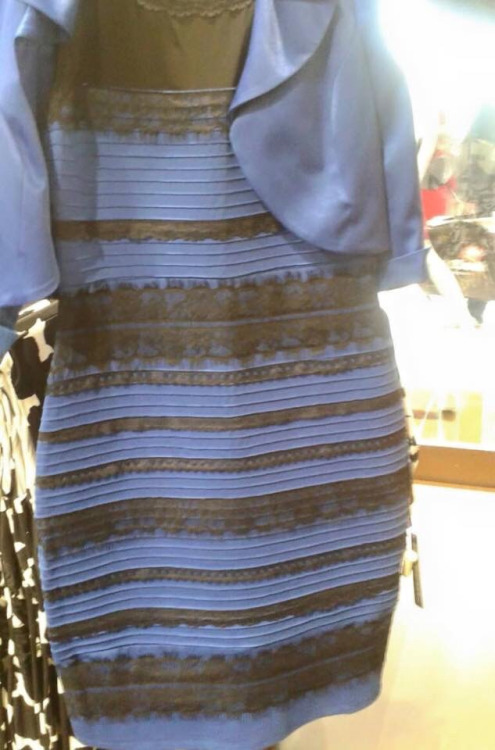Recently, the social media world has been torn asunder by a controversy concerning the color of a dress. It may seem a little ridiculous, but it appears that the internet cannot agree whether the dress is blue with black lace or white with gold lace. The fight is about more than social media; it’s about primal human physiology and the way our eyes and brains have evolved to see the world around us in the ever changing shades of daylight.
The brain, kept safe in the bony darkness of the skull, relies on our eyes to supply an image of the outside world. However, before the mind can perceive what the eyes see, light must be converted to electrical impulses which are then interpreted by the brain. Light enters the eye through the lens and hits the retina, located at the back of the eye. Pigments in the retina fire neural connections, converting the light to electrical energy and transmitting it to the visual cortex. There, the mind processes the signals into an image. Light has wavelengths which correspond to different colors, and the first burst of light to enter your eye is made up of whichever wavelengths are illuminating the world around you as they bounce off the object you are looking at. Your brain is able to asses which color is being reflected as part of the ambient light and subtract it from the “real” color of the object.
“Our visual system is supposed to throw away information about the illuminant and extract information about the actual reflectance,” says Jay Neitz, a neuroscientist at the University of Washington. “But I’ve studied individual differences in color vision for 30 years, and this is one of the biggest individual differences I’ve ever seen.” (Neitz sees white-and-gold.)
Normally, that visual system works just fine. This image of the dress, however, falls within a perceptual boundary. Human beings evolved to see in daylight, which is not a constant source of light. From the pinkish cast of dawn, to the bright blue-white of midday, and down to the red-gold of sunset, daylight changes colors. What happens in the context of the dress is the brain tries to filter out the chromatic bias of the daylight axis that it perceives. “So people either discount the blue side, in which case they end up seeing white and gold, or discount the gold side, in which case they end up with blue and black,” says Bevil Conway, a neuroscientist who studies color and vision at Wellesley College.
The point is, your brain tries to interpolate a kind of color context for the image, and then spits out an answer for the color of the dress. As to why so many people seem to perceive the dress differently, we don’t just perceive visual stimuli naively, but we perceive them in the context of what we have encountered before. This learned expectation is known as a “prior.” It is quite possible that some people (early birds versus night owls) have a different prior based on what kind of illumination conditions they encounter more frequently. Or there could be a complex interaction between the two.
Meanwhile, one lesson that we can take from all of this is that it is just because we see something in a certain way doesn’t mean that everyone else will see it in the same way. Additionally, it doesn’t mean that our perception necessarily corresponds to anything in the real world. A situation like this is a definite reminder of the benefits of keeping an open mind and the way that light helps to color and shape the world around us.




